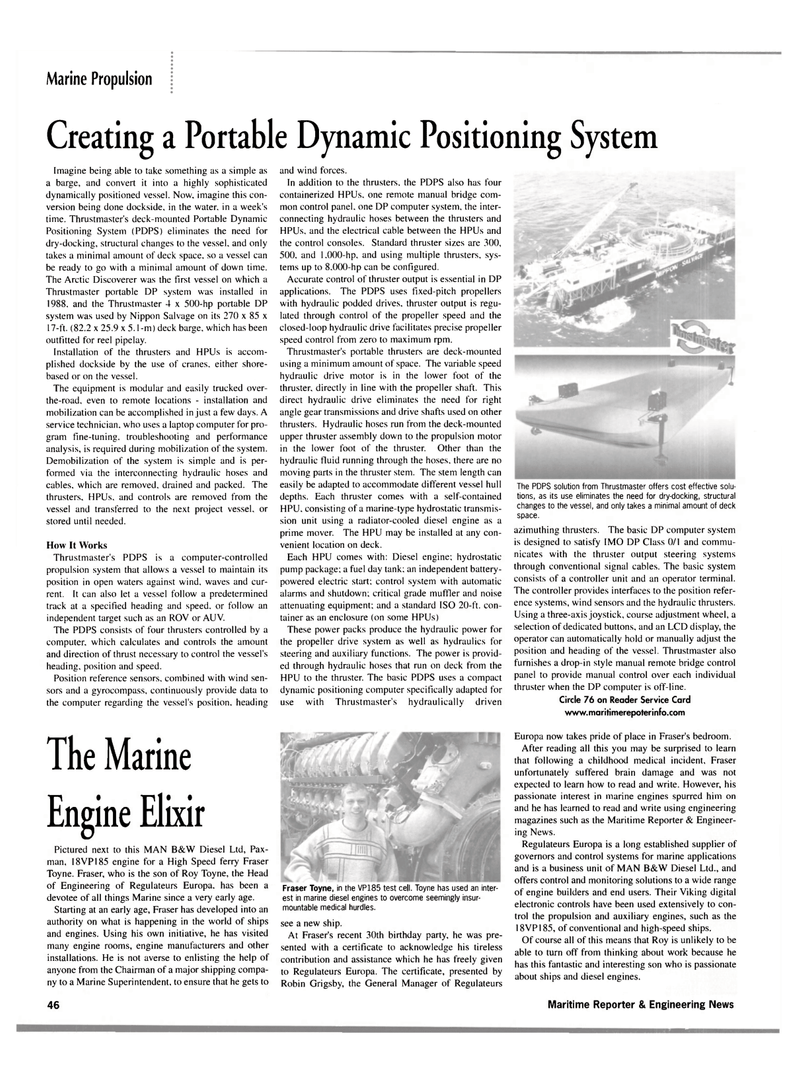
Page 49: of Maritime Reporter Magazine (January 2002)
Read this page in Pdf, Flash or Html5 edition of January 2002 Maritime Reporter Magazine
Marine Propulsion
Creating a Portable Dynamic Positioning System
Imagine being able to take something as a simple as a barge, and convert it into a highly sophisticated dynamically positioned vessel. Now, imagine this con- version being done dockside, in the water, in a week's time. Thrustmaster's deck-mounted Portable Dynamic
Positioning System (PDPS) eliminates the need for dry-docking, structural changes to the vessel, and only takes a minimal amount of deck space, so a vessel can be ready to go with a minimal amount of down time.
The Arctic Discoverer was the first vessel on which a
Thrustmaster portable DP system was installed in 1988, and the Thrustmaster 4 x 500-hp portable DP system was used by Nippon Salvage on its 270 x 85 x 17-ft. (82.2 x 25.9 x 5.1-m) deck barge, which has been outfitted for reel pipelay.
Installation of the thrusters and HPUs is accom- plished dockside by the use of cranes, either shore- based or on the vessel.
The equipment is modular and easily trucked over- the-road, even to remote locations - installation and mobilization can be accomplished in just a few days. A service technician, who uses a laptop computer for pro- gram fine-tuning, troubleshooting and performance analysis, is required during mobilization of the system.
Demobilization of the system is simple and is per- formed via the interconnecting hydraulic hoses and cables, which are removed, drained and packed. The thrusters, HPUs, and controls are removed from the vessel and transferred to the next project vessel, or stored until needed.
How It Works
Thrustmaster's PDPS is a computer-controlled propulsion system that allows a vessel to maintain its position in open waters against wind, waves and cur- rent. It can also let a vessel follow a predetermined track at a specified heading and speed, or follow an independent target such as an ROV or AUV.
The PDPS consists of four thrusters controlled by a computer, which calculates and controls the amount and direction of thrust necessary to control the vessel's heading, position and speed.
Position reference sensors, combined with wind sen- sors and a gyrocompass, continuously provide data to the computer regarding the vessel's position, heading
The Marine
Engine Elixir
Pictured next to this MAN B&W Diesel Ltd, Pax- man, I8VP185 engine for a High Speed ferry Fraser
Toyne. Fraser, who is the son of Roy Toyne, the Head of Engineering of Regulateurs Europa. has been a devotee of all things Marine since a very early age.
Starting at an early age, Fraser has developed into an authority on what is happening in the world of ships and engines. Using his own initiative, he has visited many engine rooms, engine manufacturers and other installations. He is not averse to enlisting the help of anyone from the Chairman of a major shipping compa- ny to a Marine Superintendent, to ensure that he gets to and wind forces.
In addition to the thrusters, the PDPS also has four containerized HPUs, one remote manual bridge com- mon control panel, one DP computer system, the inter- connecting hydraulic hoses between the thrusters and
HPUs, and the electrical cable between the HPUs and the control consoles. Standard thruster sizes are 300, 500. and 1.000-hp, and using multiple thrusters, sys- tems up to 8.000-hp can be configured.
Accurate control of thruster output is essential in DP applications. The PDPS uses fixed-pitch propellers with hydraulic podded drives, thruster output is regu- lated through control of the propeller speed and the closed-loop hydraulic drive facilitates precise propeller speed control from zero to maximum rpm.
Thrustmaster's portable thrusters are deck-mounted using a minimum amount of space. The variable speed hydraulic drive motor is in the lower foot of the thruster. directly in line with the propeller shaft. This direct hydraulic drive eliminates the need for right angle gear transmissions and drive shafts used on other thrusters. Hydraulic hoses run from the deck-mounted upper thruster assembly down to the propulsion motor in the lower foot of the thruster. Other than the hydraulic fluid running through the hoses, there are no moving parts in the thruster stem. The stem length can easily be adapted to accommodate different vessel hull depths. Each thruster comes with a self-contained
HPU, consisting of a marine-type hydrostatic transmis- sion unit using a radiator-cooled diesel engine as a prime mover. The HPU may be installed at any con- venient location on deck.
Each HPU comes with: Diesel engine; hydrostatic pump package; a fuel day tank; an independent battery- powered electric start: control system with automatic alarms and shutdown; critical grade muffler and noise attenuating equipment; and a standard ISO 20-ft. con- tainer as an enclosure (on some HPUs)
These power packs produce the hydraulic power for the propeller drive system as well as hydraulics for steering and auxiliary functions. The power is provid- ed through hydraulic hoses that run on deck from the
HPU to the thruster. The basic PDPS uses a compact dynamic positioning computer specifically adapted for use with Thrustmaster's hydraulically driven
Fraser Toyne, in the VP185 test cell. Toyne has used an inter- est in marine diesel engines to overcome seemingly insur- mountable medical hurdles. see a new ship.
At Fraser's recent 30th birthday party, he was pre- sented with a certificate to acknowledge his tireless contribution and assistance which he has freely given to Regulateurs Europa. The certificate, presented by
Robin Grigsby, the General Manager of Regulateurs
The PDPS solution from Thrustmaster offers cost effective solu- tions, as its use eliminates the need for dry-docking, structural changes to the vessel, and only takes a minimal amount of deck space. azimuthing thrusters. The basic DP computer system is designed to satisfy IMO DP Class 0/1 and commu- nicates with the thruster output steering systems through conventional signal cables. The basic system consists of a controller unit and an operator terminal.
The controller provides interfaces to the position refer- ence systems, wind sensors and the hydraulic thrusters.
Using a three-axis joystick, course adjustment wheel, a selection of dedicated buttons, and an LCD display, the operator can automatically hold or manually adjust the position and heading of the vessel. Thrustmaster also furnishes a drop-in style manual remote bridge control panel to provide manual control over each individual thruster when the DP computer is off-line.
Circle 76 on Reader Service Card www.maritimerepoterinfo.com
Europa now takes pride of place in Fraser's bedroom.
After reading all this you may be surprised to learn that following a childhood medical incident, Fraser unfortunately suffered brain damage and was not expected to learn how to read and write. However, his passionate interest in marine engines spurred him on and he has learned to read and write using engineering magazines such as the Maritime Reporter & Engineer- ing News.
Regulateurs Europa is a long established supplier of governors and control systems for marine applications and is a business unit of MAN B&W Diesel Ltd., and offers control and monitoring solutions to a wide range of engine builders and end users. Their Viking digital electronic controls have been used extensively to con- trol the propulsion and auxiliary engines, such as the 18VP185, of conventional and high-speed ships.
Of course all of this means that Roy is unlikely to be able to turn off from thinking about work because he has this fantastic and interesting son who is passionate about ships and diesel engines. 46 Maritime Reporter & Engineering News

 48
48

 50
50
